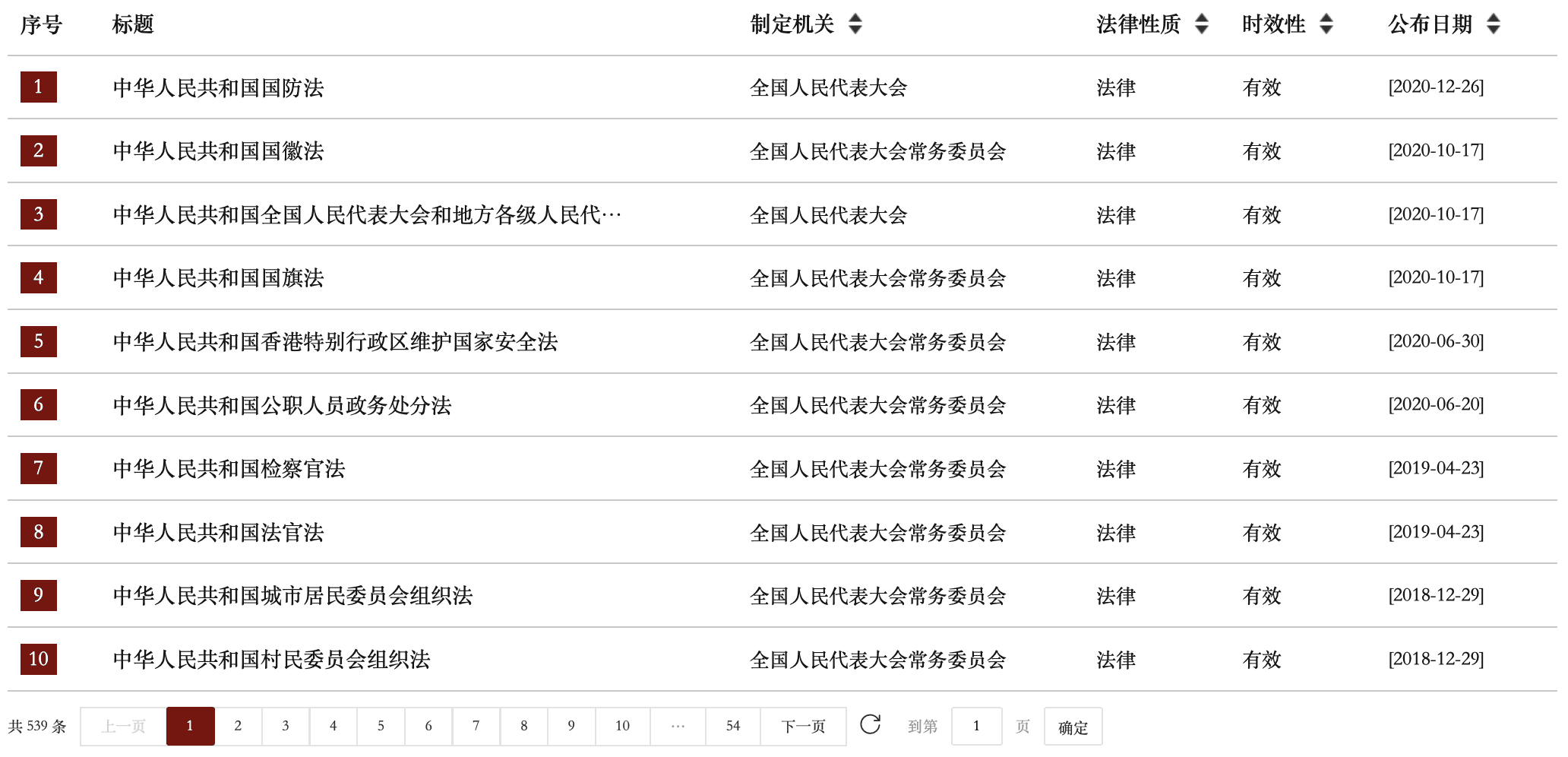The National People’s Congress (NPC) on Wednesday, February 24 formally launched a database of Chinese legal authorities: the National Database of Laws and Regulations [国家法律法规数据库]. The Database has been years in the making. According to the Legal Daily, work on it started in November 2017 and was scheduled to complete by end of 2018. Yet it ended up taking a lot longer—and as we will discuss below, the Database still has had a bumpy start. In this post, we will introduce the types of legal authorities currently available in the Database. We will then discuss its three main functions: browsing, search, and download. And we will end with some concluding thoughts on the Database and look ahead to its future versions. The bottom line: the Database in its current form will not be our go-to platform for looking up Chinese legal documents.
Current Collections
The version that went online on Wednesday is officially Phase I of the Database. Broadly speaking, Phase I collects two types of legal authorities: (1) those enacted by the NPC or the NPC Standing Committee (NPCSC); and (2) those filed with the NPCSC for recording. These authorities are shown below, categorized by their enacting organs. Their respective numbers as of February 24, 2021 are given in parentheses.
- NPC & NPCSC
- Constitution [宪法]
- Constitutional amendments [宪法修正案] (6)
- Statutes [法律] (274)
- Legislative interpretations [法律解释] (25)
- Decisions concerning legal issues or major issues [有关法律问题和重大问题的决定] (147)
- State Council
- Administrative regulations [行政法规] (609)
- Supreme People’s Court & Supreme People’s Procuratorate
- Judicial interpretations [司法解释] (637)
- Local legislatures (16,000+ combined)
- Local regulations [地方性法规]
- Autonomous regulations [自治条例]
- Separate regulations [单行条例]
- Special Economic Zone regulations [经济特区法规]
The Database indicates that “decisions concerning legal issues or major issues” are only partially included. It is also apparent by glancing at the front page that its collection of judicial interpretations is fairly outdated; the most recent one was issued in July 2020. The other categories do seem reasonably up to date. For the majority of documents, the Database includes only their most current versions.
Supervisory regulations [监察法规] issued by the State Supervision Commission are also filed with the NPCSC but are not included in Phase I. The reason might be that the Commission has yet to adopt any such regulations.
Phase I is missing a large number of Chinese legal authorities, including rules issued by State Council agencies or local governments. That might be because the NPCSC is for the moment the sole manager of the Database, but does not receive filings of those other authorities. Phase II of the Database is expected to include additional authorities, as we will discuss in more detail below.
Browsing
1. Frontpage. There are eight main sections on the Database’s frontpage (screenshotted below). At the top is a menu bar, with tabs for five categories of legal authorities:
- Constitution;
- Laws (which include all authorities adopted by the national legislature);
- Administrative regulations;
- Local legislation; and
- Judicial interpretations.

Below the menu bar is a search bar, to which we will return in the next section.
Further down the page are six boxes: one for each type of authorities shown in the menu bar—and also one for new legislation (“新法速递”). Some of the boxes include tabs for secondary categories. For instance, the “Laws” box (screenshotted below) has tabs for “statutes,” “legislative interpretations,” and “decisions concerning legal issues or major issues.” It also contains tabs for the seven official areas of Chinese law: “Constitution-related laws,” “civil and commercial laws,” “administrative laws,” “economic laws,” “social laws,” “criminal laws,” and “litigation and non-litigation procedure laws.” To give another example: the “local legislation” box has a tab for each mainland province.

The frontpage displays a few of the most recent documents in each category (and subcategory). Each document is followed by its promulgation date (in the format of “year-month-day”).
2. Category page. After clicking on a tab in the menu bar, you will be directed to the page for the corresponding category of authorities. Alternatively, you could get there by clicking on the “more” [更多] icon in each box on the frontpage. (A screenshot of the “Laws” page is shown below.) Each category page shows a list of ten documents in that category—you can view additional documents, ten at a time, by clicking on the page tabs. Each entry in the list shows the document’s title, enacting organ, legal nature [法律性质] (e.g., statute), current status (e.g., repealed), and promulgation date. You can sort the list by the latter four criteria.

3. Document page. Each individual document page starts with the document’s title and an informational section next to a QR code (which links to a Word version of the document) (see example below). That section lists the document’s “rank in the legal hierarchy” [法律效力位阶] (i.e., its legal nature), enacting organ, current status, effective date, and promulgation date.

A standard document reader occupies most of the page. Across the top are four icons that allow you to, respectively, jump between pages, adjust the zoom level, make the text selectable (and searchable), and select the viewing mode (i.e., single page or continuous scroll).
Above the upper right corner of the reader are two red buttons. The second, “WPS 版本” (WPS version), is selected by default (WPS is a productivity software developed by a Chinese company and is compatible with Microsoft Office). The first, “公报原版” (original gazette version), would display the document as it was originally published in the enacting organ’s gazette. Under the Legislation Law [立法法]—and the Database also emphasizes this point—the gazetted version is the authoritative version of the document and would prevail over the WPS version in the event of inconsistency (see arts. 58, 71, 79). Not every document’s gazetted version is available, however; in that case, only the WPS button would appear.
Search
The Database’s search function allows for search by “title only” [标题], by “body text only” [正文], or by “full text” [标题+正文]. Search by body text or full text is not currently working, however; all search queries return only the documents with responsive titles.
The search function also allows for “exact match” [精确查询] or “approximate match” [模糊查询] of the keyword(s), but it appears that all queries look for an exact match no matter the mode selected. It also appears that the search function does not recognize multiple keywords—which are instead treated as a single keyword without the space(s) in between. Hence “枪支 管理” (firearm + control) returns the Firearms Control Law [枪支管理法] (and a few other documents), whereas “管理 枪支” (control + firearm) returns no result.

You can narrow your search by a document’s effective date (you can specify a range); promulgation date (same); current status (i.e., not yet effective, effective, amended, or repealed); enacting organ; or type of authority. Like a category page, the search results page also shows ten results per page. And you can likewise sort the results by enacting organ, legal nature, current status, or promulgation date.
Download
On each document page, there is a “download” [下载] button hovering on the right side (see screenshot below). By default, clicking it will download a Word version of the document. If the gazetted version is chosen, then it will download a non-text-searchable PDF version (as the file consists of images only). You can also download a Word version on your phone by scanning the QR code on the page.

It appears that the Database’s Word versions were provided by pkulaw.com [北大法宝] (previously known in English as “China Law Info”), a leading commercial legal database in China. The Hong Kong National Security Law’s Word version, for instance, has the same hyperlinked texts as the version on pkulaw.com, and all links are in the form of http://fagui.pkulaw.cn:18080/* (which do not actually work). The private company confirmed that it had been recruited by the NPCSC to work on the Database. Not deleting the links seems to be an unfortunate oversight.
Further, the files downloaded from the Database have names consisting of seemingly random numbers and letters. And unlike the official PDFs of legislation offered for download by some other governments (e.g., Hong Kong and the United States), the PDFs downloaded from the Database are not encrypted and thus may be doctored (although their image-only format somewhat alleviates this concern).
Mobile Experience
The Database’s website currently does not have a mobile version. Except that text selection is not available on a mobile device, all other functions do appear to work to the same extent as they do on desktop. (Text search within a page also works on a mobile browser, once the “text selection” mode is activated.)
The NPCSC also launched a WeChat Mini Program version of the Database on Wednesday. (For those unfamiliar, WeChat Mini Programs are essentially apps within an app.) While this version is optimized for mobile devices (see screenshots below), text selection is still not available, and all other functions work (if at all) the same way they do on desktop.

Overall Assessment
Phase I of the Database is not terrible, not great.
Make no mistake: building and launching a free, authoritative, comprehensive, and easy-to-use database of all Chinese legislation is an endeavor that should be praised. Phase I does mark a big step towards that ultimate goal. It is freely accessible. Its user interface is fairly intuitive. And compared to other official legal databases now or once out there, it includes a lot more authorities and has done a great job categorizing them. It is also the first database of any kind that offers authoritative gazetted versions of legal documents.
Yet Phase I still feels underwhelming even considering the enormity of the whole project. It is missing a sizable portion of Chinese legislation. It does not have a readily available mobile version. Its search function is rudimentary and does not fully work. It does not allow searching within a document (beyond a web browser’s own in-page search function). Text selection is a hassle and not mobile-friendly. And there is no internal linking to past or future versions of a document or other cross-referenced documents.
Phase I is good for reading the documents you are able to locate, but not much more.
Looking Ahead
The NPCSC has already started building Phase II of the Database.
Phase II will include rules [规章] adopted by State Council agencies and local governments. It will incorporate, via external links, the international treaties that China has joined as well as the laws of Hong Kong and Macau. And it might even add the Communist Party’s internal regulations, military regulations and rules, and judicial opinions in some manner.
Phase II of the Database will also display the history of a document’s enactment and any subsequent amendment, revision, repeal, or interpretation, and will allow visitors to access all its historical versions. And it is expected to improve the Database’s search and other core functionalities so that it becomes “smarter.”
For our part, we suggest that the NPCSC consider merging the Database with its online platform for private entities to request review of the validity of sub-statutory documents. That platform is essentially also a database of (some categories of) legal authorities—with the added function to request review of their validity. Unlike the Database, that platform also links to the legislative records of the documents it has collected (although none can now be successfully viewed or downloaded). Merging the two platforms could greatly enrich the legislation database, promote public awareness of the documents-validity review process, and concentrate the NPCSC’s resources on a single project.
We also suggest that Phase II of the Database link to the English translations of national laws that the NPCSC has been gradually posting on its English website. This seems another quick and easy way to improve the Database with the NPCSC’s existing resources.
The Database could be great. We hope it will not be long before it gets there.
